Final Fantasy Mystic Quest (Super Nintendo) Review
By Albert Lichi  20.12.2017
20.12.2017
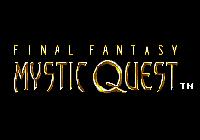
It was the fall of 1992 when Final Fantasy Mystic Quest hit the West, and over time it has achieved a fairly negative reception among Final Fantasy fans. Most Western fans see it as a representative of how some publishers underestimate their customers because the entire pitch of the game was to "specifically gear an RPG towards the US market. Some of the ire might have been some fans feeling bitter for missing out on Final Fantasy V and getting a simplistic game such as this one, but did Mystic Quest deserve the bad reputation? Cubed3 looks back on the often forgotten and unnumbered Final Fantasy title for SNES.
The early to mid-90s saw some of the greatest RPGs of all time. In the same year Mystic Quest came out, there were the likes of Soul Blazer and Shining Force. The RPG genre was just about to hit its stride thanks to the SNES hardware, which would have led to some of the most beloved titles of all time. Squaresoft at the time would become infamous for holding back on some of the best RPGs it would make, and games like Seiken Densetsu 3 and the many Romancing Saga entries would never officially leave the shores of Japan.
RPGs used to be very challenging to localise being that in the 90s having all that text translated was far more time consuming and expensive that it hardly was worth it for publishers to even bother bringing them to the West. RPGs were still kind of niche at the time and Squaresoft felt that the Western audience needed to be carefully weaned on the style of gameplay. This is where Mystic Quest comes in.

The whole point of Mystic Quest was to make an entry level RPG. The target age demographic is not clear, but it's safe to assume that this was a game aimed at children. The story is very simple and doesn't amount to anything beyond a plain good guy going to beat an evil king, all while collecting the plot coupons to progress. There is not much characterisation, either, since the hero, Benjamin, has no real personality. At best, his sprite is kind of amusing when he shrugs and looks like a goofball. Even the party members and supplementary cast do not have any real definable characteristics outside of what their designs suggest them to be. Bearing in mind that this is an RPG meant for kids who are just figuring out how to read and do basic math, it is still a functional RPG where goals are clear and all basic questions are answered without leaving much for plot holes.
The combat system is reflective of how the game's story is written and who the game is meant for. The turn-based combat could not be any simpler since a party can only consist of Benjamin and whoever the story deems is his partner at the time. To further emphasise the very young target audience, even the party's stats can be displayed in a much simpler and visual way, with life bars instead of numerical values to mitigate the user having to do calculations.
Even the way Mystic Quest handles encounters is a bit unusual since all enemies appear on the world, but they never move and they never respawn. At the end of the game, it creates a situation where the world is completely barren of things to do since there are no more enemies to fight. This means no grinding at all, either.
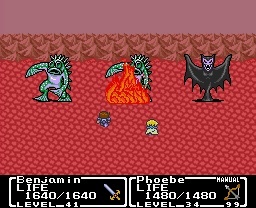
There are these arenas that have a limited amount of battles that can be done, and this is the closest Mystic Quest comes to a side-quest. It should also be mentioned that these battles are the closest means that anyone can grind in this game. On one hand, this is kind of refreshing to not have to always worry about what level the party needs to be, but in Mystic Quest's case, since the story is so simple, there really isn't anything else of interest to latch onto.
When not in the turn-based battles, Mystic Quest kind of plays a bit like a clunky Zelda game. Benjamin can cut through bushes, chop down trees, bomb walls, and even use a hookshot to progress. Each of these tools also work in battle and can only be acquired by progressing in the linear story. Dungeons and other locations are a bit more interesting to explore since there is an element of logic involved, as Ben now has to use the right tool for the right job. It is never really complicated, and most people will cruise through this game like it's nothing. Kids who haven't played RPGs much before will probably enjoy themselves.

Mystic Quest was an early SNES game and it shows. Its pixel art sits in that sort of limbo that makes it look like an NES game with way more colour. There are some neat visual flourishes that make this game actually more sophisticated than the later numbered Final Fantasy titles, like how large boss sprites will change and depict them as slowly weakening. Why this wasn't ever implemented in other 2D RPGs is a mystery because it served as a good metric on how far along progress is in a battle. There really is not much going on with the pixel art, and it is just around serviceable for an early SNES RPG.
The one standout quality in Mystic Quest is the music. The soundtrack composed by Ryuji Sasai and Yasuhiro Kawakami is really impressive, and it is a shame that it didn't get the same attention as the scores by Nobuo Uematsu. The tracks used for the battles and boss battles are standout pieces that manage to elevate the pedestrian strategy and adds some much needed urgency to encounters. They almost sound like heavy metal music with their fast tempo and pseudo electric guitar samples. This track was so awesome that is was added to Theatrhythm Final Fantasy, because Square Enix saw the potential that it music had for a rhythm game.
Mystic Quest got the raw deal and has been given a stigma it does not deserve. There is a very clear effort to make something that was digestible for newcomers, and while it may come at the expense of depth, the team really brought their A-game to make sure this was a polished product. Squaresoft probably could have marketed it differently and dropped the "Final Fantasy" ties altogether to avoid comparisons, but then it might not have gotten any attention at all had they did that. Gaming parents who want to play an RPG with their children that even they can understand really can't do better than this.
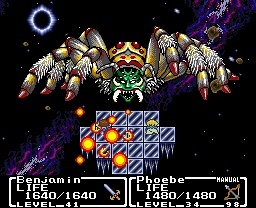
Cubed3 Rating
Very Good - Bronze Award
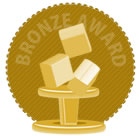
Some people grew up with Mystic Quest and have fond memories of it, and with nostalgia notwithstanding, it still proves to be a reasonably competent RPG for young gamers who are ready to start reading books and basic arithmetic. People who were already experienced with RPGs and went into Mystic Quest were destined to not have a good time since that's like a college student expecting substance out of The Cat In The Hat. There really is not much to this RPG and that is for the benefit of the target audience. There is not a single aspect that will satisfy the older, more experienced and cynical RPG fan because this is a title that is obviously designed for young children. As someone who's first experience with an RPG was Mystic Quest, the game did its job beautifully.
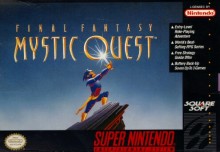
Mystic Quest Legend
![]() 7/10
7/10
![]() 8/10
(2 Votes)
8/10
(2 Votes)
 Out now
Out now  Out now
Out now  Out now
Out now  Out now
Out now Comments
Comments are currently disabled

 Sign In
Sign In Game Details
Game Details Subscribe to this topic
Subscribe to this topic Features
Features





 Top
Top

